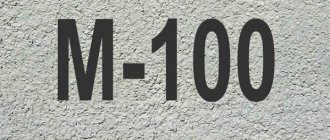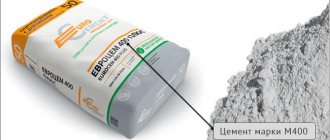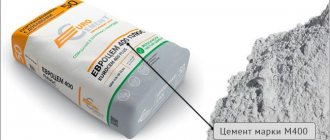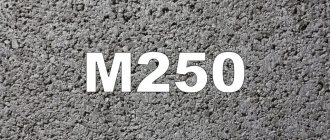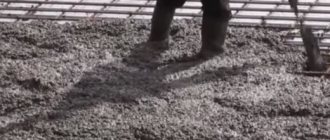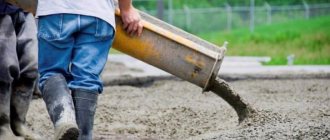M100 concrete is a type of heavy concrete characterized by a low “load” capacity and, accordingly, a limited scope of application. In some unreliable online publications, this building material is characterized as “light”. Actually this is not true.
Concrete grade M100 consists of “heavy” components and “submits” to the requirements of the current regulatory document - GOST 26633-2015 “Heavy and fine-grained concrete. Technical conditions".
Where is M100 concrete used?
The relatively small load-bearing capacity of this grade of concrete has determined a relatively limited scope of application. In particular, heavy concrete m100 GOST 26633-2015 is used in the following construction and concrete works:
- Preparatory concrete work.
- Repair of defects in concrete structures and structures.
- Construction of concrete floors in interior spaces.
- Arrangement of blind areas around private and office buildings.
- Construction of pedestrian paths in private and country houses.
- Installation of curbs and other road preparation work.
It should also be noted that in Soviet times, 7.5 m100 concrete was widely used as the main material for the construction of walls of one-story residential buildings, which are successfully used to this day, without any questions about strength and durability.
Therefore, if a private developer is faced with the task of erecting a one-story house building up to 3 meters high, the technical characteristics of M100 concrete will fully ensure the strength and durability of the structure, all other things being equal.
Why do you need concrete preparation for the foundation?
In projected construction, the installation of bases for foundations is carried out in accordance with the requirements of the set of rules 50-101, in paragraph 12.8.6 of which a recommendation is made regarding the footing. It sounds like this: a preparatory layer of concreting 100 mm thick must be provided under any monolithic foundation (and not just a slab) - regardless of the type of continental soil (the exception is rocky soil).
Expert opinion Vitaly Kudryashov builder, aspiring author
Ask a Question
In some cases, it is allowed to make sand or crushed stone preparation with a surface cement-sand screed instead of a full-fledged slab of lean concrete, but justification is required for such a replacement.
Why is concrete footing needed specifically for monolithic foundations? There are several reasons, and all, as they say, are valid:
- Concrete is a good rigid water barrier. In this case, it will work in two directions: from above it will prevent the leakage of cement laitance when pouring the main slab, and from below it can restrain, for example, the pressure of groundwater.
- Such a barrier becomes effective and impermeable to ground moisture thanks to an additional waterproofing carpet made of rolled bitumen material mounted on top of the concrete base. It also protects the roll waterproofing from mechanical damage.
- The slab foundation, and accordingly its frame, has a large horizontal area. To tie the reinforcement, installers have to move inside the formwork, so the base underneath must support the weight of people and not deform. The footing has the necessary rigidity and, together with the formwork, sets the correct geometric shape for the foundation slab.
- Below the preparatory concrete layer there is always a sand or crushed stone cushion. Together, these two layers of the foundation pie form a pillow of a stable shape, and act as a kind of damper between the house and the ground, distributing the loads more evenly.
Expert opinion Vitaly Kudryashov builder, aspiring author
Ask a Question
Please note: You can do without a footing when constructing a ground slab for a small object, since groundwater rarely comes close to the surface. In this case, in private housing construction, a polyvinyl chloride profile membrane is simply laid under the slab, combined with an additional layer of bitumen roll waterproofing.
In the surface version, under the house slab there is only a sand cushion and 2 layers of rolled waterproofing
If the slab foundation is buried in the ground - for example, to build a basement floor, preparatory concreting must be provided.
Types of preparation, except concrete
The installation of a sub-concrete slab is not carried out directly on the mainland soil; most often it is preceded by several more preparatory layers. We have already mentioned the PVC membrane, which in private housing construction often replaces concrete footings. The main preparatory layers are bulk cushions made of crushed stone, sand or a mixture thereof.
A backfill made of pure crushed stone or gravel is ineffective from the point of view of load-bearing capacity, since it does not compact well. Such backfilling is mainly carried out when constructing reservoir drainage in conditions of high groundwater levels. The average thickness of this layer is 15 cm.
Sand does not drain moisture as well as crushed stone, but it compacts better when wet and holds its given geometric shape. Therefore, it is laid either on top of crushed stone or mixed with coarse material in the mass, which makes it possible to achieve the greatest degree of compaction.
Expert opinion Vitaly Kudryashov builder, aspiring author
Ask a Question
Under the bulk layer there is usually also a layer of geotextile fabric. It allows water to pass through, but retains soil particles, preventing the cushion from eroding and becoming silted with clay.
Sand cushion on geotextiles
Specifications
- Strength of concrete m100: 98 kg/cm2.
- Water resistance: W2-W4.
- Frost resistance: F50-F100.
- Mobility (workability): P2-P4.
- The average weight of concrete is m100: 2270 kg per 1 m3.
Conclusion. If a developer wants to use this building material as the main building component, he should make appropriate calculations for the strength that walls built from M100 class 7.5 concrete can withstand. As practice shows, private and country one-story houses built from M100 concrete have sufficient load-bearing capacity and durability to “stand” for up to 50 years or more.
Description and Application
Concrete M100 has a low price with a relatively low strength indicator, so it can only be used where there are no large mechanical loads. It corresponds to concrete strength class B7.5 and is used in the production of reinforced concrete structures that will not be subjected to high pressure and dynamic influences. This material is sufficiently waterproof to create a reliable barrier to the laitance of higher grade concretes poured onto a bed of M100. It has a relatively low density, which reduces the pressure on the soil surface.
When selecting a building mixture, attention is paid to three main parameters: strength, moisture resistance, frost resistance. It is they who determine the scope of application of B7.5 or M100 concrete, which is limited due to reduced performance due to the small amount of cement. This solution is used for the following work:
- Installation of concrete pads under bases and foundations on compacted soil or sand. Their purpose is to prevent the binder component from sinking into the ground. In addition, such layers create an additional waterproofing barrier, protecting structures and reinforcement from corrosion.
- During road construction, this material is used as a substrate for the base of the road surface, when constructing pedestrian zones and areas for vehicles that are subject to high loads.
- For casting curbs, small unloaded structures, arranging infrastructure elements, children's and sports grounds.
- For pouring subfloors in utility rooms during private construction, for example, in a barn, workshop or cellar, laid on the ground.
Composition of concrete M100
Like other brands of heavy concrete, M100 consists of: granite or crushed gravel (filler), quarry or river sand, Portland cement CEM I 32.5N PC (M400) or CEM I 42.5N PC (M500) and clean fresh water. Due to the limited scope of application, additives are not added to this brand of concrete.
For lightly loaded structures (blind area, garden path, preparatory work) erected on private farmsteads, it is allowed to use slag formed by burning coal, broken bricks and other construction waste as filler.
Purpose
Concrete V7.5 (M100) belongs to the group of lean concretes, which are subsequently not subjected to significant loads, that is, they cannot form structures for any purpose. The main purpose of this material is to prepare for the installation of more durable materials:
- Strengthening the soil for laying the foundation;
- Fixation of underlying cushions under road surfaces, sidewalks, foundations;
- Construction of a subfloor on the ground under the finishing screed;
- Preparation of sites for storing construction materials on site;
- Landscaping of the local area, for example, laying garden paths and flower beds.
Concrete 7.5 grade 100 serves as a substrate for the reinforcement cages - rods are installed on it, after which working concrete of higher grades is poured.
Proportions of concrete M100
For the convenience of user-developers, we summarize the proportions of the components and their quantities required to prepare 1 meter of cubic material in the following table:
Table 1.
| Cement brand | Proportions C:P:SH:H | Number of components for preparing 1 m3 of concrete | |||
| Cement, kg | Sand, kg | Crushed granite, kg | Water, l | ||
| M400 | 1:4,4:6,8:1,1 | 175 | 755 | 1150 | 190 |
| M500 | 1:5:7,3:1,2 | 158 | 770 | 1150 | |
At a construction site, it is not always possible to measure concrete components in kilograms. Therefore, “by default”, when preparing a batch, developers use a universal “measure” - a “bucket”. That is, they measure the proportions of concrete in 100 m buckets. We bring the data in Table 1 to a “10 and 12 liter bucket” and summarize them in Table 2:
Table 2.
| Cement brand | Number of components for preparing 1 m3 of concrete in 10 liter buckets, pcs. | Number of components for preparing 1 m3 of concrete in 12 liter buckets, pcs. | ||||||
| Cement | Sand | Crushed stone | Water | Cement | Sand | Crushed stone | Water | |
| M400 | 13,5 | 54 | 82 | 19 | 11,2 | 45 | 68,5 | 15,8 |
| M500 | 12,2 | 55,3 | 82 | 10,1 | 45,8 | 68,5 | ||
When calculating the “buckets”, the following average reference values for the bulk density of materials were used:
- Cement: 1,300 kg/m3.
- Sand: 1,400 kg/m3.
- Crushed stone fraction 20-40 mm: 1,400 kg/m3.
Proportions and composition
To prepare concrete grade M100, you will need standard components - cement, sand, crushed stone and water. Sometimes additives such as plasticizers are used to improve quality or other fillers that reduce the density of this material.
Requirements for placeholders remain standard. The sand must be washed from a quarry or river; a gravel-sand mixture is allowed. The recommended crushed stone fraction is medium; limestone, gravel or granite material is used. This filler affects the strength indicator, since crushed limestone has a lower value of this value than granite. Water for concrete grade 100 is purified, without acids and salts dissolved in it.
The ratio of ingredients depends on what Portland cement is used for the solution. For the M400 cement grade, two options are offered in mass and volume fractions. In mass fractions per one part of cement, taken in kilograms, centners or tons, the following is taken:
For M500, the ratio of fillers changes; for one part you will need:
In volume fractions in cubic meters or in liters, fillers are taken for M400:
When using M500 cement for the production of M100 concrete, the composition for one part of the binder will be as follows:
The amount of water is adjusted to achieve optimal hardness and mobility of the solution.
To obtain one cubic meter of M100 concrete mixture with average performance from M400 cement you will need:
- cement – 250 kg;
- sand – 0.58 m³;
- crushed stone – 0.8 m³;
- purified water – 210 l.
It is taken into account that during construction, cement is taken in kilograms, and the remaining ingredients in volume fractions.
Concrete mixers are used to make the composition, since the quality directly depends on the thoroughness of mixing the components. In private construction, manual mixing is allowed.
Cost of concrete M100
The price of concrete prepared on your own consists of the cost of the components and the cost of electricity spent to operate the concrete mixer. If you prepare concrete according to the old method - on a sheet of iron, the last factor can be ignored. The last factor can be ignored. To calculate the cost of 1 m3 of M100 concrete, we will set the average prices for the most affordable Portland cement M400 packaged in 50 kg bags, quarry sand and granite crushed stone:
- Average cost of one 50 kg bag of M400 cement: 230 rubles.
- Average cost of 1 m3 (1.4 t) of quarry sand: 200 rubles. (0.14 rub./kg).
- Average cost of 1 m3 (1.4 t) of granite crushed stone: 1,750 rubles. (1.25 rub./kg).
Using the component consumption data from Table 1, we calculate how much the M100 solution prepared on our own will cost: (175/50)x230+(755X0.14)+(1150x1.25)=910+105.7+1437=2,453 rubles.
For comparison, the cost of M100 concrete ordered at a concrete plant is from 2,850 to 3,680 rubles, depending on the filler (gravel or granite) and the manufacturer. Due to the significant dependence on distance, the delivery of components and ready-mixed concrete was not taken into account.
Composition and preparation
Class B7.5 concrete is no different in composition from its “brothers”, except for the proportions:
| Cement | Sand | Crushed stone | Amount of concrete from 10 liters of cement, l |
| Cement m400 | |||
| 1 | 4,6 | 7,0 | 78 |
| Cement m500 | |||
| 1 | 5,8 | 8,1 | 90 |
Table of volumetric proportions
Number of components for preparing 7.5 cubic meter of concrete:
- Cement M400 - 250 kg,
- Sand - 0.58 m 3,
- Crushed stone - 0.8 m 3,
- Water - 0.21 m3.
- Cement M400 - 206 kg,
- Sand - 750...780 kg,
- Crushed stone - 1177 kg,
- Water - 175...180 l.
The requirements for the composition of concrete 7.5 are specified in GOST 26633-2012 “Heavy and fine-grained concrete”. According to the document, to prepare the solution, you can only use fillers that are free of debris, dust and organic impurities, cement of specified grades, and the use of additives-plasticizers that improve the composition is allowed in an amount of no more than 5%.
Sand can be of any type, crushed stone can be limestone or gravel. Its strength is enough to work with a light load.
For concrete mortar class B7.5, additives are rarely used if the material is intended for laying under heavy structures. It is possible to introduce a superplasticizer or PVA for installing paths in the garden.
It’s easy to prepare the solution: you can use a concrete mixer or a shovel - there are no strict requirements for mixing due to the low responsibility of the finished products.
- Dry fillers (sand and crushed stone) are mixed in a concrete mixer or in a trough with a shovel;
- Add cement in portions and mix;
- Gradually introduce water in small parts, mixing the mass with a shovel, mixer, or you can use a mixer.
The amount of water is not strictly standardized, but its amount should not exceed 100% of the binder mass. Otherwise, the cement will not set and the effect of a durable bedding will not be achieved.




